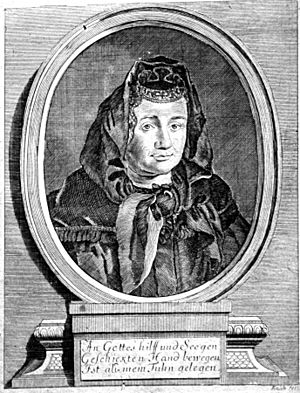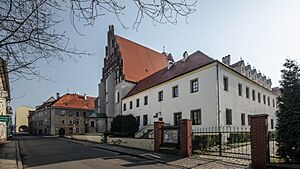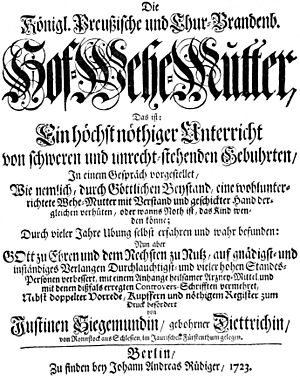Justine Siegemund facts for kids
Quick facts for kids
Justine Siegemund
|
|
|---|---|

Justine Siegemundin
|
|
| Born | 26 December 1636 |
| Died | 10 November 1705 (aged 68) |
| Other names | Justine Dittrichs |
| Occupation | German writer |
Justine Siegemund (born December 26, 1636 – died November 10, 1705) was a famous midwife from Lower Silesia, a region in Germany. She wrote a very important book called The Court Midwife in 1690. This book was one of the most widely read guides on childbirth written by a woman in Germany.
Contents
Justine Siegemund's Early Life
Justine was born in Rohnstock, a town in what was then the Duchy of Jawor. Her father, Elias Diettrich, was a Lutheran minister. He passed away when Justine was just fourteen years old in 1650.
In 1655, she married Christian Siegemund, who worked as an accountant. They were married for 42 years. Even though they didn't have children of their own, Christian supported Justine a lot in her career. At that time, it was usually thought that only midwives who had given birth themselves could practice.
Becoming a Midwife: 1656–1672
When Justine was twenty, she had a difficult experience with midwives who mistakenly thought she was pregnant. This personal struggle made her want to learn everything she could about childbirth.
She first helped with a difficult birth in 1659. The baby's arm was in the wrong position, causing problems. For over ten years, until 1670, she helped poor women and peasants in her area for free. Slowly, she also began to help women from wealthy merchant and noble families.
Justine's Professional Midwifery Career: 1670–1701
Justine's skills became well-known. She was even called to help Luise, the Duchess of Legnica, who had a growth that needed to be removed. Justine successfully removed it, even after male doctors asked for her help.
However, some male doctors were jealous of her success. In 1680, a former supervisor named Martin Kerger accused her of unsafe practices. But other doctors at the Frankfurt on Oder medical school supported Justine. They saw that Kerger didn't have her practical experience.
His false claims didn't stop Justine. In 1670, she became the "city midwife" of Legnica. Her amazing skills also caught the attention of Frederick William, Elector of Brandenburg. He appointed her as his "court midwife" in Berlin in 1683.
She also served as the royal midwife for Frederick III's sister, Marie-Amalie. Justine helped deliver four of Marie-Amalie's children. She also assisted Christiane Eberhardine, the Saxon Electress, when she gave birth to her son in 1696. At the same time, she continued to help with other births in the Berlin area.
While in the Netherlands, Mary II of Orange suggested that Justine should write a training book for midwives. Justine had likely already started working on her book, The Court Midwife.
Justine Siegemund rarely used medicines or surgical tools in her work. By the time she passed away on November 10, 1705, in Berlin, she had helped deliver almost 6,200 babies. This amazing number was noted by the church leader at her funeral.
The Court Midwife (1690)
In 1689, Justine traveled to Frankfurt on Oder to show her book draft to the medical school there. They approved her medical information. She included detailed drawings of the body and how babies develop, which made the book very helpful. She also made sure to protect her ideas by getting special printing rights from important leaders.
In Leipzig, she faced another challenge from a male doctor named Andreas Petermann. He made similar accusations to Kerger. But because Petermann had less experience, Justine was able to defend her professional reputation once again.
Justine had kept careful notes during her many deliveries. Based on these notes, she published her important book, The Court Midwife, in 1690. The book is written as a conversation between Justine (herself) and Christina, a student.
The Court Midwife was very organized and based on real experience. It explained how to handle many difficult childbirth situations. These included problems like babies being in the wrong position, issues with the umbilical cord, and problems with the placenta.
Justine also shared a special technique for a difficult situation called a shoulder presentation. This is when the baby's shoulder comes first, which was often very dangerous. She developed a two-handed method to gently turn the baby inside the mother. She is also credited with finding a way to help with bleeding caused by a low-lying placenta.
After Justine Siegemund died, The Court Midwife was printed many more times. Later versions even included information about the challenges she faced from Kerger and Petermann.
Works
- Die königl[ich-]preußische und chur-brandenb[urgische] Hof-Wehe-Mutter : das ist: ein höchst nöthiger Unterricht von schweren und unrecht stehenden Gebuhrten, in einem Gespräch vorgestellet, wie nemlich durch göttlichen Beystand, eine wohl-unterrichtete Wehe-Mutter mit Verstand und geschickter Hand dergleichen verhüten, oder wanns Noth ist, das Kind wenden könne ; mit einem Anhange heilsamer Arzney-Mittel und ... Controvers-Schriften vermehret .... Berlin : Rüdiger, 1723 Digital edition of the University and State Library Düsseldorf.




